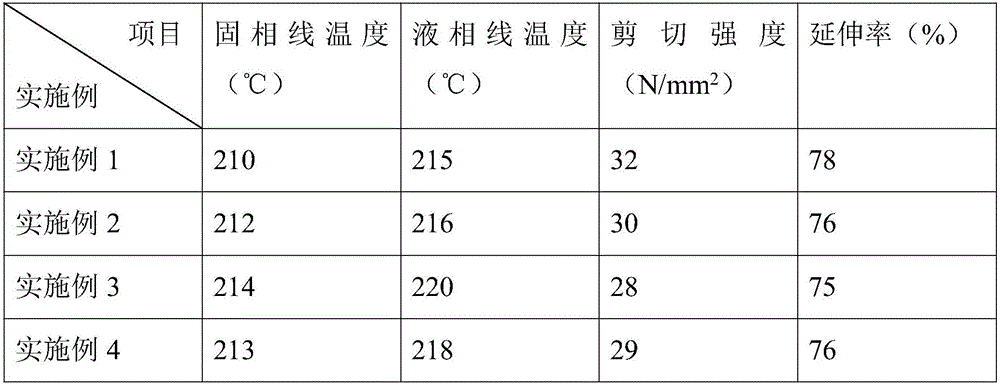Tin antimony solder alloy
A technology of solder alloys and raw materials, applied in the field of tin-antimony solder alloys, can solve problems such as application limitations, achieve the effects of improving stability, reducing solder temperature, and improving shear resistance
- Summary
- Abstract
- Description
- Claims
- Application Information
AI Technical Summary
Problems solved by technology
Method used
Image
Examples
Embodiment 1
[0017] A tin-antimony solder alloy, calculated by weight percentage, comprising the following raw materials:
[0018] 12% of antimony, 2.4% of silver, 6% of zinc, 0.6% of nanometer ferric oxide particles, 0.06% of vanadium and 0.004% of Pr, and the balance is tin. The particle size of the nanometer ferric oxide particles is 50nm.
[0019] Preparation:
[0020] According to the Sb, Ni, Zn, nano-Fe in the present embodiment 2 o 3 , V, weight percentage of Pr and Sn Weigh the required raw materials, add them into the furnace, then heat up to 500°C to melt, start timing after complete melting, and keep warm for 120min. During this period, stir with a ceramic rod every 10 minutes to fully homogenize the alloy components. Two hours later, take the hot crucible out of the furnace, put it in air to cool down to room temperature (20° C.), and then take it out from the crucible to obtain the tin-antimony solder alloy of the present invention.
Embodiment 2
[0022] A tin-antimony solder alloy, calculated by weight percentage, comprising the following raw materials:
[0023] 14% of antimony, 2.8% of silver, 6% of zinc, 0.4% of nanometer ferric oxide particles, 0.03% of vanadium and 0.003% of Dy, and the balance is tin. The particle size of the nanometer ferric oxide particles is 10nm.
[0024] According to the Sb, Ni, Zn, nano-Fe in the present embodiment 2 o 3 , weight percent of V, Dy and Sn Weigh the required raw materials, add them into the furnace, then heat up to 480°C to melt, start timing after complete melting, and keep warm for 120min. During this period, stir with a ceramic rod every 10 minutes to fully homogenize the alloy components. Two hours later, take the hot crucible out of the furnace, put it in air to cool down to room temperature (20° C.), and then take it out from the crucible to obtain the tin-antimony solder alloy of the present invention.
Embodiment 3
[0026] A tin-antimony solder alloy, calculated by weight percentage, comprising the following raw materials:
[0027] 10% of antimony, 3.0% of silver, 8% of zinc, 0.8% of nanometer ferric oxide particles, 0.1% of vanadium and 0.006% of Nd, and the balance is tin. The particle size of the nanometer ferric oxide particles is 10nm.
[0028] The preparation method of the low-melting-point lead-free solder in this embodiment is the same as the method described in Embodiment 1, the only difference is that the weight percentages of the components of the lead-free solder alloy are weighed according to the proportions in this embodiment.
PUM
| Property | Measurement | Unit |
|---|---|---|
| Particle size | aaaaa | aaaaa |
| Particle size | aaaaa | aaaaa |
Abstract
Description
Claims
Application Information
 Login to View More
Login to View More - R&D
- Intellectual Property
- Life Sciences
- Materials
- Tech Scout
- Unparalleled Data Quality
- Higher Quality Content
- 60% Fewer Hallucinations
Browse by: Latest US Patents, China's latest patents, Technical Efficacy Thesaurus, Application Domain, Technology Topic, Popular Technical Reports.
© 2025 PatSnap. All rights reserved.Legal|Privacy policy|Modern Slavery Act Transparency Statement|Sitemap|About US| Contact US: help@patsnap.com

